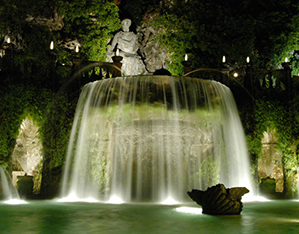Villa d’Este, together with Villa Lante and Caprarola feature the three most famous Renaissance gardens of Lazio and, in the attempt to emulate the nearby Villa Adriana this Villa d’Este is truly unique. For its harmonic combination of Art and Nature and its almost intact original structure, it is a UNESCO World Heritage Site.
We owe this villa to the cultured and refined Cardinal Ippolito d’Este, named governor of Tivoli in 1550 – who intended to revive the splendours of the d’Este golden era and of French courts where he had sojourned – and to his architect and antiquarian Pirro Ligorio. Key to understanding this park is the allegorical and obviously celebratory itinerary touching on themes such as Vice and Virtue – references to Ippolito d’Este, identified with the figure of Hercules, and whose emblems can be found just about everywhere in the park. The garden plan is structured on a grille of orthogonal pathways based on a cardo-decumanus crossing. The cardo massimo, the main avenue, coincides with the central loggia of the villa built on two levels: along this path are the Leda Fountain, the Fountain of the Dragons and the Rotonda dei Cipressi. The fountains along the decumani paths are of particular interest, especially the fountain on the path of the Cento Fontane (the Hundred Fountains): prior to the waterways of Bagnaia and Caprarola, this is the first amazing example of a garden water axis, stretching out between the Sibilla or Ovato Fountain and the Rometta Fountain, along the line connecting the two opposite poles of the Tempio della Sibilla Tiburtina and the city of Rome, visible on the horizon. Parallel to this is the Peschiere (fishpond) axis with the spectacular backdrop of the Fontana dell’Organo and its water display. The exceptional availability of water connected to a deviation of the River Aniene (the Estense Canal) permitted the creation of these numerous fountains giving rise to a truly spectacular and symbolic itinerary. Water is omnipresent in the form of spectacular effects, quiet ponds and basins, noisy jets, gurgling cascades, elaborate water features and, thanks to ingenious devices, even birdsong and clamouring firearms sound effects that at present have only partially been restored.
Highlights

Fontana dell'Ovato
This spectacular nymphaeum is one of the first water theatres, dated 1565-69. A wide oval basin with an exedra along the back wall that alternates niches and arches with ten statues of Nereids in peperino tuff. On top there is a terrace with balustrade and a statue of the Tiburtine Sibyl.

Fontana della Civetta
This fountain testifies to the spread of garden mechanical figures creating amazing and astonishing effects. The large niche of this fountain in fact featured a complex hydraulic system with twenty painted bronze mechanical birds that could move and sing only to be silenced by the arrival of an owl (civetta) letting out a piercing screech.

The Mostra d’acqua
Below the Fontana dell’Organo – whose hydraulic structure, inspired by antique examples described in ancient sources is attributed to Claude Venard – is the grandiose “mostra d’acqua” a spectacular water display whose current structure dates to 1927 and substitutes the spectacular artificial cascade created by Gianlorenzo Bernini in 1661. Jets and sprays of various heights flow into three large basins. Originally the central niche of the Fontana dell’Organo held a statue of Diana of Ephesus which was subsequently placed along the garden wall.
 Villa d’Este
Contacts
Villa d’Este
Contacts
Contacts
Telephone:+39 0774 768082
Other contacts::- Ticket office +39 0774 332920
- Call Center: tel. 199.766.166
- fax: +39 0412770747
For bookings from abroad:
- [email protected]
- fax: +39 0412770747
- phone: +39 0412719036
Address
Piazza Trento, 5
00019 , Tivoli (RM)
This garden is part of these circuits

 Villa d’Este
Opening times and prices
Villa d’Este
Opening times and prices
Opening hours
From 1 November, the monumental complex of Villa d’Este will be open as follows:
- 8.30 am – 7.45 pm (the ticket office closes at 6.45 pm).
- on Mondays the opening is from 2.00 pm
- Closed on: Monday mornings, January 1 and December 25, except for special openings on project that are reported on the
website
of the Villa.
From Monday, September 14, 2020 until March 15, 2021, the ticket office will close one hour earlier than the exit time from the garden, which will be from Piazza Campitelli due to the Covid-19 emergency. The time of exit from the Garden is linked to the setting of the sun in the relevant month:
- January: 4:45 p.m;
- February: 5:15 p.m;
- March: 6 p.m. (with daylight saving time 7 p.m.);
- April 7.15 pm;
- from May to August: 7.30 p.m;
- September: 7 p.m;
- October: 6.15 pm (with standard time 5.15 pm),
- November and December: 4.45 p.m.
The Villa will in any case remain open until 7.45 p.m., last admission 6.45 p.m., with the RED IN THE EVENING project, which guarantees visitors a reduced ticket price of € 6.00 (with exhibition) from the time the ticket office closes for the month in question, without prejudice to the concessions provided by the regulations for admission to Italian cultural sites, which can be consulted on the MiBACT website. The visit does not include the Garden, which is not illuminated, but it is possible to admire the Cloister, some rooms of the Palace and the Grand Avenue with a panoramic view of the sunset from the Arc de Triomphe. The exit is on Trento square.
Pricing
New entry modes and fees as of May 27, 2020 for Covid-19 emergency
The entrance for visitors is on Piazza Trento, the obligatory exit is from Piazza Campitelli.
- Ordinary full price ticket: € 12.00 (with exhibition), subject to the concessions provided for by the entry regulations for Italian cultural sites, which can be consulted on the MiBACT website.
- Full price ticket € 10,00, subject to the concessions provided by the entry regulations for Italian cultural sites, which can be consulted on the MiBACT website. These rates may vary in conjunction with exhibitions taking place inside the monument.
- Proximity fare at 50% compared to the ordinary full fare for all residents of Tivoli and neighbouring municipalities (Castel Madama, Guidonia Montecelio, Marcellina, San Polo dei Cavalieri, San Gregorio da Sassola, Vicovaro and Rome – Rome until 30.06; Palestrina and Subiaco): € 6.00
- 2 euro discount rate ‘Villae con voi’ on the ordinary ticket upon presentation of a receipt of at least 10 euro issued not more than 24 hours ago by an authorized shop: € 10,00
On the occasion of the exhibition Ecce Homo: the encounter between the divine and the human for a different anthropology (16 October 2020 – 10 January 2021), the cost of the full ticket is € 12.00.
For information about the routes of visit and to know the structures and merchants adhering to “Villae with you”, consult the website.
Free
The Ministerial Decree of January 9, 2019, effective February 28, 2019, provides :
- free entrance every first Sunday of the month from October to March (suspended for security reasons_Covid-19);
- Free admission during Museum Week (in 2019 from 5 to 10 March);
- additional 8 days of free admission established by the Institutes: the VILLAE promote free admission every first Monday of the month from May to December (suspended for security reasons_Covid-19);
- ticket of 2 euro for young people from 18 to 25 years old. for further facilitations: MiBACT website 8 March
International Women’s Day, free entry for women in state museums and cultural sites (Circ. no. 10 of 29/02/2016 Direzione Generale Musei) - We would also like to point out the initiative concerning free admission reserved for the citizens of Tivoli and neighbouring municipalities (Castel Madama, Guidonia Montecelio, Marcellina, San Polo dei Cavalieri, San Gregorio da Sassola, Vicovaro, except for Rome) every Monday, starting at 2.00 p.m. (suspended for security reasons_Covid-19).
 Villa d’Este
How to get there
Villa d’Este
How to get there
Address
Piazza Trento, 5
00019 , Tivoli (RM)
Latitude: 41.9624821
Longitude: 12.7589193
How to arrive by road
From Rome with the motorway A 24 exit at Tivoli. From here, take the Maremmana Inferiore road until it joins the Tiburtina state road. After the hamlet of Villa Adriana, continue on the Tiburtina state road until you reach Tivoli;
From Rome take the Tiburtina state road to Tivoli;
From L’Aquila with the A24 motorway exit Castel Madama. From here, take the Via Empolitana towards Tivoli until you reach the city.
How to arrive by train
Rome-Pescara line, Tivoli station
How to arrive by bus
Buses for the Rome-Tivoli route are operated by Cotral and leave from Ponte Mammolo station (metro station B). The stop in Tivoli is Largo Nazioni Unite. The ticket price is 2€ per trip.
Additional directions
The entrance for visitors is on Piazza Trento, the obligatory exit is from Piazza Campitelli.
 Villa d’Este
Services/Accessibility
Villa d’Este
Services/Accessibility
Services
Dogs are allowed on a leash and, if large, with a muzzle. Owners are required to pick up any droppings.
Inside the villa there are two bookshops, a multimedia room available to the public and a projection room where an introductory film about Villa d'Este is shown in four languages on a continuous cycle.
Accessibility
 Villa d’Este
Private events
Villa d’Este
Private events
 Villa d’Este
Itineraries
Villa d’Este
Itineraries
You could find the garden in these itineraries
 Favorite saving result
Favorite saving result
 Warning!
Warning!
You've have to sign up or sign in to add this element to your favorites.
